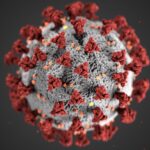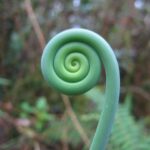My wife and I were enjoying the sunset recently while visiting the Crane Estate in Ipswich MA. The glow of the setting sun touched off the warm colors of the marsh grass in the near-view, and the blazing fall colors of trees in the mid-view. We could see shining water in Essex Bay and the rising hills of Cape Ann. Above the hills, three white towers topped by steadily rotating white blades dominated the skyline. The unsettling mix of nature and technology started a conversation – how do you feel about it?
Natural Aesthetics
Nature is beautiful. This should not be surprising, since the natural world is the foundation from which we all spring. We are living, breathing creatures that evolved in a complex, synergistic process with nature. Our physiology, our perceptions and our emotions are intimately tuned to it. While our daily lives and our minds may be increasingly surrounded by technological marvels and anthropogenic landscapes, we cannot escape our interconnectedness with nature.
The disconnect from nature we have experienced, individually and as a species, may also contribute to our fascination with the idea of nature that is undisturbed and wild. We ogle at wild animals kept in zoos, or those that increasingly roam our suburban green spaces. We treasure the spaces and landscapes that are free from artifacts. We even disguise our communication towers as trees (albeit ugly ones). These measures for the most part reflect a naïve romanticism about nature, a mythical world that many tend to embrace in the face of a vastly industrialized and denatured human world. The truth is that the human footprint is heavy. According to the 2019 Biomass Assessment, 70% of the Earth’s birds are farmed poultry, and 96% of the Earth’s mammals are humans or livestock. (See: New Perspective on the Blue Planet. ) Plastic particles have been detected from the deep ocean to the Himalayas and in a new study 29 varieties of PFAS (“forever chemicals”) have been found in the Arctic Ocean.
The romanticism about undisturbed nature shows up in the aversion many individuals and communities have to wind turbines. They are large manufactured objects that necessarily extend high above the land and the tree canopy. There is no denying their significant visual impact. Three of them tower over the visual landscape of Cape Ann. The question is – how do we respond, ethically and aesthetically, to that impact?
Technological Aesthetics
The wind turbines over Cape Ann are a technological marvel. They are grand and elegant structures, geometric in form, with long, gleaming white arms moving in languid, perfectly circular sweeps. They are, in their own way, aesthetically pleasing works of design and craftsmanship.
As my wife and I were talking, we also began to explore the question of what they do. The nacelle, the hub for the swinging arms, contains a carefully engineered machine. In simple terms, the moving arms, driven by the kinetic power of the wind, are connected to a coil of wire that spins around magnets. As a result of the phenomenon of electrical induction, discovered by Michael Faraday almost 200 years ago, the movement generates an electric current that can be captured and fed into the electric grid or a storage device. This silent and invisible process sounds like magic, and, in a way, it is! That magic sits at the heart of all the electric generators and motors that power our technological devices, and enables us to live in such a marvelous, dynamic and convenient world.
Alternative Futures
These thoughts were encouraging, but they did not resolve the dissonance we felt at seeing the wind turbines rising above the horizon. Yes, they were beautiful but did they have to be there? What difference would that make?
The simple answer is that without the wind turnbines, our homes and industries would still need the power they were generating. That would have to be produced somewhere else. That choice would almost inevitably require the increased combustion of fossil fuels – coal, oil or natural gas. These fuels and the electricity they produce constitute an extensive industry of extraction, processing and generation. Those activities have significant environmental and aesthetic impacts in other communities and other landscapes. Our view of Cape Ann might feel less dissonant, but there would be an aesthetic and environmental cost to others. Most of us would agree that exporting the consequences of our choices to others is unethical and ultimately self-defeating. If everyone does it, everyone is worse off.
In addition, the combustion of fossil fuels is a primary driver for the acceleration of global climate change, which increasingly disrupts the natural environment, globally, regionally and locally. Looking into the future, those changes will include: disruption of climate zones; increasingly powerful storms including New England’s feared nor’easters and coastal hurricanes; and rising sea levels. How might the visual landscape from Castle Hill look under those conditions. Would the marsh, trees and beaches exist? How much would be underwater? Would Cape Ann be a habitable island?
Conclusion
These thoughts did help us look at the landscape differently. The contrast between natural and industrial objects in the landscape is still evident. But that contrast is mediated by our deeper understanding of the significance of our choices and their consequences. We can appreciate the beauty of the wind turbines, and the beauty of the natural landscape. But we also appreciate the aesthetic of what the wind turbines represent. Nature and technology are different, but we have to imagine ways that human technology can coexist and cooperate with nature. With such imagination, our thoughts and values can change our perceptions.
The sun faded and darkness took over the viewscape. We could no longer see the wind turbines, or the land, or the water, or the marsh. But we could look up into the sky and see the stars.
















